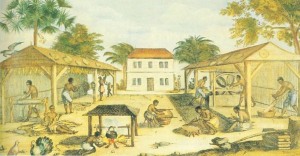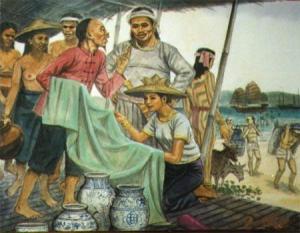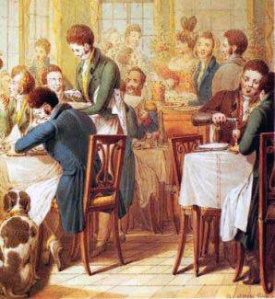Only in our evil, modern world do native flora varieties arouse such enduring hatreds.
There still exist the sick hatreds against cannabis sativa, psilocybe semilanceata, erythroxylum coca, and there is one plant that receives the coveted prize in pure hate, nicotiana tabacum.
What is so strange about this hatred is that this same plant was integrally important for European colonialism and industrial capitalism in world history. European and Euro-American civilizations could not have progressed as they did without the native american gift of tobacco plantations, working slave labor to death, and then, the tobacco processing, factory work, building even larger ships, international marketing and sophisticated advertising.
How did such an enjoyable American plant associated with native community peace, and smoked through pastes, leaves, hand-made pipes and even chewed, transform into such a European commodity fetish under global capitalism?
Nicotiana tabacum was once a naturally growing, medicinal and spiritual plant for America’s native nations. European colonial invaders, investors, and murderers transformed the plant into an export drug of commodity for elite consumption under the inexhaustible profit-making schemes of capitalism.
Columbus and his invading men did not just murder, imprison and sell native slaves on the island of Cuba during the 1490s. They also spotted some, ‘naked’ Carib natives smoking a herb placed in some leaves. The scent was quite intoxicating and the natives seemed to enjoy the community based smoke. They did not inhale, yet the effect of the plant was calming after they had eaten some fresh, delicious food, and the herb even had a sensual effect on the smokers. The European imperial-colonial invaders found another gift.
They stole the native plants from the Caribbean islands and transported them to Europe. The Europeans took a peculiar liking to them. In the 1500s, the Portuguese colonial invaders in the Americas, called Bresil, began to cultivate the native crop. It seemed to grow well in sub-tropical and tropical climates. When introduced into European aristocratic, social-parasite gardens inside of the great landed estates, tobacco plants sprouted quite well. Tobacco could also grow in mild, temperate, oceanic climates. The European elites were on to something.
During the seventeenth-century, some monarchs, political thugs and tyrants began to hate the plant. King James Stuart of England, Sultan Ammurath IV of Ottoman Turkey, and Czar Mikhail Romanov of Russia, represented some of the anti-tobacco elite crowd, while Pope Urban VIII actually had a papal bull written against the plant in the 1640s.
Yet the European colonial empires of Britain, France, Spain, the Netherlands and Portugal had succumbed to the gods of capital. Each empire set up their own royal monopolies for the plant. The annoying question was where to grab the labor in order to work long hours in the hot sun: picking, drying, curing and transporting the leaves. The Europeans had made themselves the self-proclaimed owners of nicotine tabacum, so at first, they used local penal labor to work them to death in order to enrich the tobacco lords or planters. Where could one find a continual supply of slave labor?
An even greater economic windfall emerged through such an American cultivation – the theft of human chattel, or the kidnapping, murder, transporting and working to death of African slaves.
The Portuguese had first established their monopoly of the Blackened Brown Gold during the late sixteenth-century and early seventeenth-century, (about 1560-1660). Due to the importance of such American export plantation crops, such as tobacco, the English, Dutch, (the Netherlands), and the French established their own ‘African’ slave monopolies. A plant associated with community peace and enjoyment, took on the ominous tones of legal crime, kidnapping, imprisonment, mass murder, genocide and working people to death. Tobacco actually helped birth mercantile capitalism.
Mercantile Capitalism implied royal European controls of an export commodity, such as tobacco, sugar, coffee, tea, chocolate, salt and kidnapped African slaves, while it established permanent credit to slave plantation owners in order for them to purchase a continual supply of Africans and other penal slaves, (the European looking, or white ones). The American plantation-slave owners and European tobacco traders-ship investors made their profits through inflated price sales in the home or European metropolitan markets.
Meanwhile, European navies and missionaries tried to open greater markets for the American products in the Asian continents. Slowly, nicotine snuff and tobacco smoking had spread into the Islamic world culture, then Persia-Iran, the Indian sub-continent, Central Asia and ultimately into the Far East, China and even Japan.
In the eighteenth-century, the European tobacco manufacturers developed the smaller ‘cigarette’ varieties, and for those that preferred to chew, snuff boxes. All of this cigarette finery was for elite European consumption.
Elaborate, silver inlaid snuff boxes entered the world of fashion conscious, French aristocratic-parasite bums. In Britain, gentlemen established new cultural activities, fashions and spaces besides fencing, hunting, dances, card games, tea and reading – the smoking parlor with the smoking jacket.
A good tobacco smoke was always perfect after a good meal, with some intoxicating liquor or with some fine coffee. European grifters-Latin lovers, such as the Venetian, Giacomo Casanova, also took up the habit, and so tobacco grabbed some important cultural associations within European culture: sensuality, refinement, power and a coolness under pressure.
Most importantly, King Tobacco had changed the colonial-metropolitan relationships. The Scottish Tobacco Lords transformed the city of Glasgow into the premier tobacco import-export port. These same ‘lords’ would build their mini castles along Jamaica and Virginia Streets.
Those same streets had the infamous names of the most infernal, African slave killing centers in world history.
Virginia, once a colonial outpost of disease and hardship, had become the British Empire’s premier, tobacco plantation colony on the Tidewater during the 1700s. Is it any wonder that most of America’s revolutionary founders came from this proud plantation region made rich through the marvelous drug of tobacco?
During the same eighteenth-century, the Spanish colonial authorities had established the first urban factory for cigar-cigarette paper rolling and export packaging in Mexico City. Earlier, the Spanish had established the city of Seville as the premier processing center for cigars. For over a century in colonial Spanish America, and well before Metropolitan Europe, both men and women had been openly smoking tobacco cigarettes on the public streets. American fashion and prominence had come to Europe – mainly through the marvelous and medicinal herb of nicotiana tabacum.
Throughout the nineteenth-century, the 1800s, tobacco manufacturers had developed better technology in curing and rolling for three particular products: cigars, cigarettes, (blond and black versions), and chewable snuff.
The first tobacco companies consolidated themselves, while they competed with each other for the monopoly share of the smokers and chewers’ markets. This modern tobacco industry also encouraged the adulteration of tobacco through chemical engineering in order to hold their monopolies. Tobacco products even had molasses, rum, opium or honey mixed into the final product.
Tobacco eventually became part of modern, European and Euro-American cultural life. Royalty, lazy aristos, middle class-respectable clerks, and working class dock workers took up the smoking habit. The problem was that many of the men inhaled the nicotine fumes. Certain political-economic elites, Women Christian Temperance clubs and health workers noticed the persistent coughs of regular smokers. The modern anti-smoking movement had begun.
Meanwhile, tobacco shops and kiosks became one of the standard sights found on most city streets around the world, and where they also featured other items for sale, such as newspapers, books, shaving kits, pipes, rolling papers, pen knives, board games and playing cards.
In the twentieth-century, the 1900s, the tobacco industry transformed the world of advertising and mass marketing. A few tobacco monopolies had controlled the sale of ‘cigarette packs” and they made fortunes on the drug.
Smoking found associations with soldiers during World War I and for most wars afterwards. In the 1920s, cigarette companies targeted their advertising to the ‘new woman,’ thanks to the propaganda genius of the Austrian-American, Edward Bernays. Hollywood’s golden age featured most of their stars regularly smoking the sacred plant. Can anyone forget the famous pictures of Humphrey Bogart and James Dean without cigarettes dangling from their mouths?
While tobacco use seemed to sell exponentially – and especially in Asia, the anti-smoking forces mercilessly attacked the drug. Medical experts exposed the correlations between nicotine use and cancer, emphysema and other incurable maladies.
An anti-smoking coalition emerged. This motley prohibitionist group included family survivors of smokers who had died bad deaths, medical professionals, public education school administrators, and Christian religious groups,. Political-economic elites also joined their ranks, since they wanted better workers not taking so many smoking breaks, inclusive of less corporate health care costs.
Tobacco prohibitionists began to push for greater anti-smoking legislation. By the 1980s, they had succeeded in seizing the State.
In some urban cities in the United States, smoking is highly expensive, heavily taxed, and there are petty, minute federal, state and municipal laws that dictate where a person can or cannot smoke in public. Any street vendor trying to sell cheap cigarettes from another state, now has the felon tag of a ‘contrabandist,’ and can end up in prison or even have the cops murder him. The US government has a well-armed regulatory agency against tobacco, the Bureau of Alcohol, Tobacco and Firearms, or the ATF, and so the US government has declared another war – this time against tobacco.
Yet, millions of young women, and especially models, smoke tobacco in order to help them not gain weight. Rock artists, punk musicians and other fringe artists regularly flaunt the burning cigarette in the mouth while they play their guitars brutally. Even some right-wing political activists have proudly taken the puff. The cigarette has its own sexual fetishes, and due to the US government’s war against it, now has associations with rebellion and freedom.
The history of nicotiana tabacum shows us once again, the absurdity of the human condition under civilization. A plant that once helped natives in the Americas ensure community peace and unions through the spiritual worlds, has undergone a terrible and irreversible chemical-medical-industrial-state regulated surgery.
European colonial elites had imposed this condition. They did this without the consent of the native victims of their genocides. The addictive desires for naked profits enabled another genocide against kidnapped Africans.
Most assiduously, certain corporations have claimed their own patents or imposed ‘ownership,’ on this natural plant, while they have mixed harmful chemicals into the industrial melting pot, creating a type of fuming poison. Finally, the contemporary State, ruled and administered by shameless sociopaths, constantly devises sinister means in punishing the working class smokers of the drug.
Tobacco was never the original enemy to stamp out. The sinister legacies of our European colonial settler states, once again, carry all the historical blame.





















